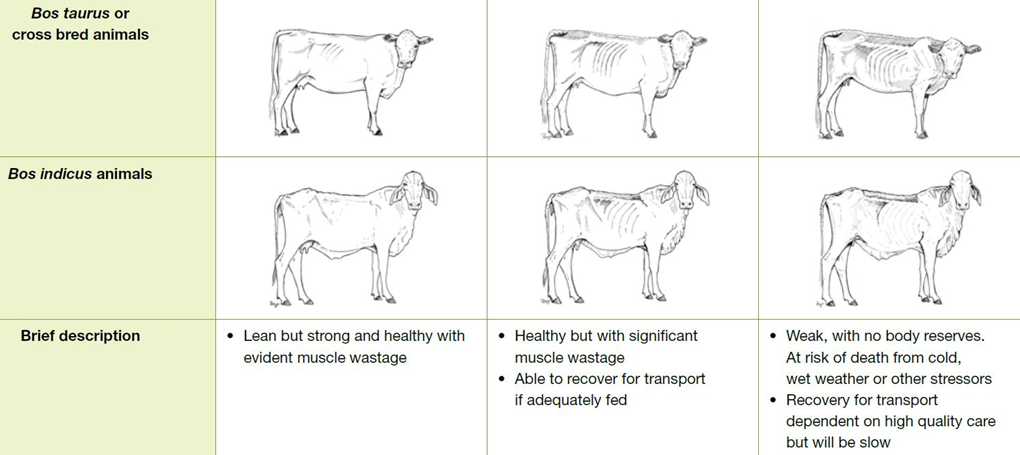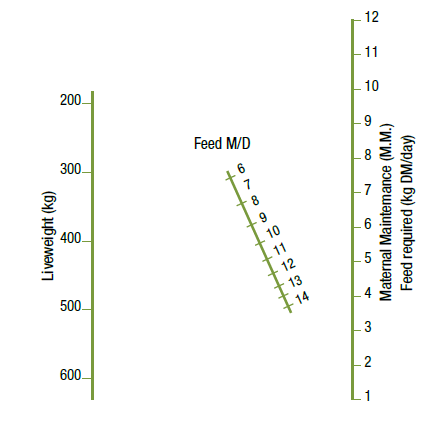Feeding cattle
Body condition score for cattle
Cattle condition can be scored on the following scale:
0—Very poor
1—Poor
2—Moderate
3—Good
4—Fat
5—Very fat
If cattle reach a condition score of 2—Moderate, they need feeding to maintain or improve condition.

Source: A national guide to describing and managing beef cattle in low body condition (2013)
The table below provides a quick estimate of the amount of feed required on a Dry Matter (D.M.) basis to maintain stock—a beast requires around 2% of its body weight per day.

- Because of the continuing drought, most feedstuffs available will be at least $600/tonne or 60 cents/kg. The cost per day for a 300 kg beast will be ≥ $3.60/day or $325 for 3 months.
- If feeding a ration other than good quality hay for >3 months, additional vitamins and minerals are necessary unless a commercially available total mixed ration is being fed.
- To calculate the amount of feed required daily, extend a straight line from liveweight (right) through the energy density (sloping line – feed M/D) to the right-hand line.
- Lactating and heavily pregnant animals will require up to twice as much feed per day.
- Treatment of young animals for internal parasites may increase the effectiveness of any feeding program
- Allow plenty of trough space to ensure shy feeders have access to the feed
- Animals with poor pasture or little pasture will lose weight and body condition. Animal owners have a duty of care to provide adequate nutrition and clean drinking water. If your pasture can’t supply the required nutrition, you will need to supplement or fully handfeed them.
-
Costs of feeding cattle
Estimating feed cost – example only (use your own feed types, quantities, prices and time frames
Stock
50:50
hay-grain mix$/t
$/kg
$/head/day
$/head/month
Weaner (200 kg)
3 kg
600
0.60 x 3 =
$1.80 x 30 =
$54
Adult dry stock (400 kg)
5 kg
600
0.60 x 5 =
$3.00 x 30 =
$90
Lactating cow (425 kg)
9 kg
600
0.60 x 9 =
$5.40 x 30 =
$162
If lactating cows are losing too much condition, calves can be weaned at two to three or even down to one month of age. Calves will need to be segregated on size and well fed, for example with good quality hay and calf pellets or grain plus protein meal, limestone and a coccidiostat such as Rumensin™.
Long-term feeding programs are likely to be uneconomic and stressful to people, stock, pastures, soils, equipment and finances. Agistment or short-term production feeding takes pressure off pastures and may be profitable. The FutureBeef website includes calculators that can help you do the sums for agistment, production feeding as well as drought feeding versus selling.
Forecasting pasture
In the subtropics, summer rainfall largely determines how much pasture grows before the end of the pasture growing season, in autumn. Higher or lower summer rainfall gives higher or lower pasture yield for carrying stock for the year ahead. For most graziers, the paddock feed and water supplies available in April or May have to last until next summer. Many graziers comment on the benefits of moving early in the year to adjust stock numbers according to pasture supply.
Generally the aim is to let stock eat about 30% of the useful feed which is available at the end of the summer growing season (or 15–20% in low rainfall environments). For example, if there is 3000 kg dry matter per hectare (ha) of useful pasture, then 30% x 3000 kg = 900 kg of useful feed per hectare. If a cow eats around 9 kg of dry matter a day, then there is about 100 days grazing per hectare; or 200 days grazing per 2 ha; or 365 days grazing per 3.65 ha. It is ideal to do these dry season pasture budgets each autumn to adjust stock numbers according to pasture availability. Winter rain may grow some high moisture, high quality herbage but usually not a significant bulk of dry matter feed.
For more information
- Feeding beef cattle
- Cattle crisis feeding
- Drought management for dairy farmers
- Managing cattle in dry conditions and drought
- Assessing pasture diet quality for cattle
- Cattle nutrition